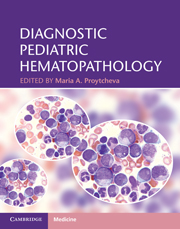Book contents
- Frontmatter
- Contents
- List of contributors
- Acknowledgements
- Introduction
- Section 1 General and non-neoplastic hematopathology
- 1 Hematologic values in the healthy fetus, neonate, and child
- 2 Normal bone marrow
- 3 Disorders of erythrocyte production
- 4 Disorders of hemoglobin synthesis
- 5 Hemolytic anemias
- 6 Inherited and acquired bone marrow failure syndromes associated with multiple cytopenias
- 7 Inherited bone marrow failure syndromes and acquired disorders associated with single peripheral blood cytopenia
- 8 Peripheral blood and bone marrow manifestations of metabolic storage diseases
- 9 Reactive lymphadenopathies
- Section 2 Neoplastic hematopathology
- Index
- References
1 - Hematologic values in the healthy fetus, neonate, and child
from Section 1 - General and non-neoplastic hematopathology
Published online by Cambridge University Press: 03 May 2011
- Frontmatter
- Contents
- List of contributors
- Acknowledgements
- Introduction
- Section 1 General and non-neoplastic hematopathology
- 1 Hematologic values in the healthy fetus, neonate, and child
- 2 Normal bone marrow
- 3 Disorders of erythrocyte production
- 4 Disorders of hemoglobin synthesis
- 5 Hemolytic anemias
- 6 Inherited and acquired bone marrow failure syndromes associated with multiple cytopenias
- 7 Inherited bone marrow failure syndromes and acquired disorders associated with single peripheral blood cytopenia
- 8 Peripheral blood and bone marrow manifestations of metabolic storage diseases
- 9 Reactive lymphadenopathies
- Section 2 Neoplastic hematopathology
- Index
- References
Summary
The hematopoietic system is not fully developed at birth, and the normal hematologic values of newborns and infants differ as compared to older children and adults. The differences are a manifestation of the unique characteristics of the embryonal and fetal development of the hematopoietic system that continues to evolve after birth. Furthermore, preanalytical and analytical factors unique for neonates and young children also contribute to these differences. This chapter will explore these factors and discuss how they define the normal hematologic values for different age groups.
Developmental hematopoiesis: a general view
The hematopoietic development, unlike any other organ system, occurs in successive anatomic sites where the hematopoietic stem cells (HSCs) are generated, maintained, and differentiate into various cell types [1]. The hematopoiesis begins in the yolk sac with the generation of angioblastic foci or “blood islands” that contain primitive erythroblasts. It then progresses further in several waves involving multiple anatomic sites: the aorta–gonadal–mesonephros (AGM) region, fetal liver, and bone marrow (BM) [2, 3]. Depending on the site of major hematopoietic activity, the hematopoiesis has been divided into three stages: the mesenchymal, hepatic, and myeloid stages with the yolk sac, liver, and bone marrow as major hematopoietic sites where hematopoietic cells with characteristic features are generated [4] (Fig. 1.1). There is a considerable temporal overlap between different stages. At birth and thereafter, the hematopoiesis is restricted to the bone marrow and continues to evolve in order to adapt to the new oxygen-rich environment and the needs of the growing organism.
- Type
- Chapter
- Information
- Diagnostic Pediatric Hematopathology , pp. 5 - 20Publisher: Cambridge University PressPrint publication year: 2011
References
- 2
- Cited by



